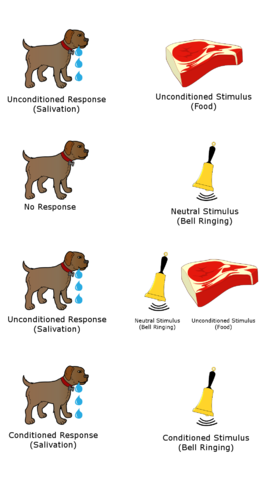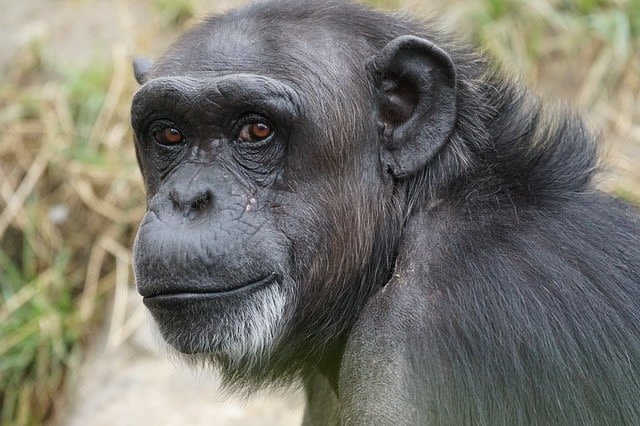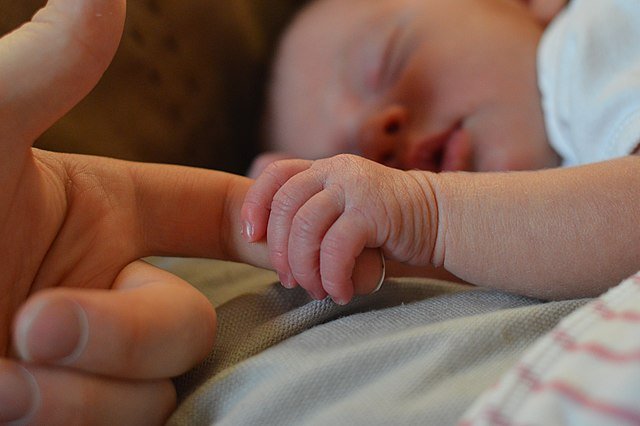SENSES AND BEHAVIOUR: Learned Responses, Complex Learning and the Work of Wolfgang Kohler and Jane Goodall.
Greetings to all my readers. Thanks for the constant support and motivations. I will start today's post by explaining more on the learned responses such as habituation and conditioning. Afterwards, I will discuss complex learning, the work of Wolfgang Kohler and Jane Goodhall. Finally, I will give an exposition on observational learning and the human behaviour.
So, sit back and let's roll.......
LEARNED RESPONSES
In a simple classification of learned responses. The following section looks in more detail at some of these responses.
Habituation
Habituation can be described as the process whereby an animal becomes accustomed to non-threatening environmental stimuli and learn to ignore them. This learning process occurs with most effect in the first few weeks of life; it is part of the socialisation and survival of most mammals. Wolf cubs, for example, must learn to recognise other wolves in their pack as non-threatening, but still be aware of the danger of wolves from other packs or from other animals such as snakes. They become habituated to other members of the pack when this response is at its most potent. After a few weeks, the response is reduced just as they start to venture out beyond the safety of their own parents and group. They cannot become habituated as easily and so are wary and fearful of things they have not come across before.
Habituation is also important for domestic animals, such as the dog. This can be illustrated by these three examples of what can happen to a puppy in its first 10 weeks of life, and how this affects how it develops into an adult:
A puppy is kept apart from its mother, given adequate food and shelter, but little contact with other dogs, or with humans. At 6 months, this dog would be fearful of people and new situations, and would not interact well with other dogs, even its own siblings.
- A puppy is kept with its mother and siblings for 10 weeks, with regular human contact and food and shelter. The dog at 6 months is likely to be well adjusted; able to interact well with other dogs, and be a good family pet.
- A puppy exposed to cruel treatment, poor conditions and physical violence in its first few weeks tends to become withdrawn and unpredictable. It may attack a person making a friendly approach.
These are examples only, but they indicate the importance of habituation in early life. Manipulation of this response can, however, be useful in some circumstances. Dogs bred for future use as police or army dogs are often exposed to loud bangs during their first weeks of life; this can enable the dog to become ‘bomb-proof’ as an adult dog, able to cope with loud, frightening conditions such as a riot, without panicking or endangering the safety of the public.
Conditioning
Conditioning is another type of learning. An animal is able to detect a stimulus and then to predict what is likely to happen, simply because it has happened several times before. The animal associates two events that occur together. For example, cattle respond to the farmer entering the field in a tractor, but ignore other people with other vehicles. They associate the farmer and tractor with food.
In his original experiments on conditioning, the Russian physiologist Ivan Palor (1849-1936) recorded saliva produced by hungry dogs that were given food. Pavlov delivered a neutral stimulus, the sound of a bell, at the same time as the food. The dogs began to connect the neutral stimulus with food, and after a short time, the animals would salivate at the sound of the bell whether food appeared or not. We now call this type of learning classical conditioning and the response it produces a conditioned reflex. It is found in all complex animals.
Since Pavlov’s initial research, many different physiological responses such as fear, dislike, love, hunger and sleepiness have been conditioned in response to a wide variety of neutral stimuli.
The other type of conditioning, operant (or instrumental) conditioning, was first described by B. F. Skinner. Operant conditioning is learning as a result of consequences. B. F Skinner invented a tool to study the animal behaviour called the Skinner box. This is a box that contains one or more levers that an animal such as a rat can press. In one of Skinner’s experiments a starved rat was introduced into the box. When the lever was pressed by the rat a small pellet of food dropped onto the food tray for it to eat. The rat soon learned that when it pressed the lever, food appeared. This is a practical demonstration of operant conditioning and learning by reinforcement.
Humans, and other animals, tend to prefer behaviours that are followed by some type of reinforcement, and they avoid behaviours that are followed by some type of punishment. Classical conditioning occurs when an animal learns to associate a ‘neutral’ stimulus with an important one: the dog associates the bell ringing with the arrival of food. Operant (instrumental) conditioning occurs when an animal learns to associate an action with a ‘punishment’ or a ‘reward’: a bird learns that eating a particular butterfly makes it sick. Reinforcement can be either positive – getting something good – or negative – losing something bad. Reinforcement can occur only sometimes in connection with a particular behaviour (partial reinforcement), or every time that behaviour is followed (continuous reinforcement). Continuous reinforcement is generally the most effective at bringing about learning.
Punishment can be effective in reducing unwanted behaviours, particularly if it is administered soon after the unwanted behaviour, consistently, and either not too weakly or extremely in relation to the behaviour (i.e. the punishment must fit the crime). However, too much reliance on punishment as a tool to modify behaviour can be counterproductive in the long run because it doesn’t teach new behaviours (it only eliminates old ones), it models aggression and it creates a negative association between the person doing the punishing and the punishment itself.
COMPLEX LEARNING
Not all learning is the result of conditioning or habituation. When a banana is left just out of reach outside its cage, a chimp might use a nearby bamboo pole to pull in the fruit. Or, if a banana is tied to the branch of a tree, again out of reach, the chimp may eventually stack boxes one on top of another and climb up to reach it. This behaviour appears to involve reasoning and we call it insight learning. If one chimp watches the behaviour of another, and then copies it, this is observational learning.
It is well known that birds and mammals form an attachment to people or animals that they come into contact with shortly after hatching or birth. This behaviour is called imprinting and it allows a young animal to learn the characteristics of its parents. This is particularly important where young animals need to learn quickly who their parents are. Young ducks, for example, follow their parents to the water soon after hatching.
Image of duck by Patou Ricard from Pixabay
Social behaviour
There is safety in numbers. Schools of fish are less vulnerable to predators than single fish: large numbers tend to confuse a predator. Living in a group may also give benefits in terms of feeding success – for example, flocks of birds eat better than single individuals because group members can ‘share’ tasks such as keeping a lookout when feeding. Birds such as geese are also more likely to find food when there are many pairs of eyes to look for it. We call this type of group behaviour social behaviour.
In a society, individuals cooperate. Animals take on individual tasks, a practice called division of labour, and there are complex systems of communication involving recognition of either family or other species members. Social organisation can range from the simple co-operation between a male and a female during mating to the complex societies of insects and primates.
Group living also has its costs. In a large bird colony, for example, males run the risk of females mating with other males. Females run the risk of mate desertion. In mixed-species flocks such as Australian finches, there can be increased competition for food and in any large group there is always the risk of contracting disease or parasites.
THE WORK OF WOLFGANG KOHLER AND JANE GOODHALL
Kohler's chimps: A hundred years ago, people thought that only human beings made and used tools, but we now know that many animals, including birds, make and use tools, One of the first scientists to show this was Wolfgang Kohler, a psychologist who studied learning in chimpanzees. Kohler, who trained at the University of Berlin, was working at a primate research facility maintained by the Prussian Academy of Sciences in the Canary Islands when the First World War broke out. Marooned there, he had at his disposal a large outdoor pen and nine chimpanzees of various ages.
Kohler decided to make the best of this situation, and set up a series of experiments to test his theory that chimps were capable of insight learning, just as humans are.
Kohler worked mainly with four chimps; Chica, Grande, Konsul and Sultan. He placed a chimp in an enclosed play area. Somewhere out of reach he placed a prize, such as a bunch of bananas. To get the bananas, the chimp would have to use an object as a tool. The objects in the play area included sticks of different lengths and wooden boxes. He discovered that chimpanzees were very good at using tools. They used sticks as rakes to pull in bananas, and as clubs to bring down fruit that was hanging overhead. Sometimes they stood long sticks on end and quickly climbed up the 7 metres and grabbed the bananas before the stick fell over. The chimpanzees also learned to use boxes as a stepladder, dragging them under the hung bananas and even stacking several boxes on top of one another. Kohler concluded that his chimps were showing insight learning – they were looking at a problem, at what was available to solve it, and then thinking up a strategy before carrying it out.
Image of a Chimpanzee by Marcel Langthim from Pixabay
Jane Goodall
Another scientist, Jane Goodall, has since observed chimpanzees making and using tools in the wild. As a young woman, Goodall worked on a project in Africa, under the direction of Louis Leakey, the famous archaeologist and anthropologist. As part of this study, she observed a chimp pick a blade of grass and carefully trim the edges. The chimp then stuck the grass into a termite mound, left it there for a moment, and pulled it out.
Termites swarmed over the blade of grass. He then ate the termites clinging to the grass blade, which had been made into a ‘fishing rod’ for termites.
Observational learning
One advantage of living in groups is that animals gain information from one another. Young animals, such as juvenile mammals and birds, learn skills from their parents by watching and observing. On the Japanese island of Koshima, macaque monkeys learned to wash dirty sweet potatoes originally provided for them by researchers in the early 1950s. This behaviour was passed on from parents to offspring and was observed by other members of the troop. After a few months, all the monkeys were washing their potatoes in the sea. Nearly 50 years later, this colony of monkeys still wash their potatoes even though they are not given dirty potatoes any more. Scientists think they like the salty taste.
Closer to home, blue tits and great tits have learned the ‘trick’ of opening milk bottle tops to get at the cream inside. These birds already had the habit of hammering and pecking at nuts with their beak. It was therefore a relatively small step to use the same technique on attractive, shiny bottle tops. This behaviour did not spread randomly but seemed to spread from certain focal points, suggesting that birds learned by watching each other.
In both these examples, observational learning occurred. The behaviour spread rapídly through the population until it became the norm. We call this phenomenon cultural transmission.
Human behaviour
Consider two examples of human behaviour:
- If children see pictures of small children’s faces and adult faces they prefer the adult face. A change in preference occurs at 12 to 14 years of age in girls when they express a preference for baby pictures. Boys display the same trend two years later.
- If we sit too close to a stranger in a library, then we tend to use physical ‘barriers’ such as books or bags to keep the stranger at a distance. If this person gets too close we often move seats.
These are typical of the types of behaviour studied in human ethology – the biology of human behaviour, It asks the question ‘why do we behave the way we do?
Ethologists view human behaviour in the same way as that of other animals: they think it is adaptive and has evolved to suit its purpose. In the two examples above, there is strong evidence to link children’s behaviour with child rearing and adult behaviour with protection.
An adult and infant. Wayne Evans, CC0
One goal of human ethologists is to look for patterns of behaviour shared by all peoples of the world. These are seen in examples of behaviour which involve body movements, rather than speech. Gestures such as smiling and raising the eyebrows, and behaviours such as grooming and hugging seem to be common to all human societies.
We all think that we have a free choice in our behaviour, but do we really? We may be under the control of our genes or be shaped by our surroundings. There is evidence for both points of view.
SUMMARY
After going through all my posts on this topic starting from SENSES AND BEHAVIOUR: 1, 2, 3 and this final post, you should know and understand the following:
- A sensation is a general state of awareness of a stimulus; perception involves the interpretation of sensory information. A receptor is a biological transducer: it converts energy from one type of system (e.g. chemical) to another system (e.g. electrical). A receptor is classified according to the type of stimulus it receives (e.g. photoreceptor), its location (e.g. interoceptor) or its level of complexity.
- The Pacinian corpuscle is a simple receptor in the skin that detects pressure and vibration. The eyeball contains three outer layers, the sclera, choroid and retina. Incoming light rays are refracted (bent) by the cornea and by the lens of the eye. Accommodation is the ability to focus the eye automatically, to see near and distant objects. Rod and cone cells are stimulated by the effects of light on two pigments, rhodopsin and iodopsin. Breakdown of these compounds alters the electrical properties of the cell membranes.
- There are three types of cone cell pigment. Each responds to a different range of wavelengths of light. Humans have trichromatic vision: our cone cells detect three colours: blue, green and red. Stereoscopic vision enables us to perceive depth and distance. The human ear has two main functions, to detect sound and to maintain balance.
- Ethology is the study of animal behaviour under natural conditions. Patterns of behaviour are controlled by the nervous system; simple behaviours include taxes and kineses. A taxis is an orientation response related to the direction of the stimulus. A positive taxis describes movement towards a stimulus; a negative taxis, movement away from a stimulus.
- A kinesis is an orientation behaviour where the response relates not to the direction of the stimulus but to its intensity. Instinct or innate behaviour is unlearned. It has survival value. There are three main types of learning: Habituation (learning not to respond), conditioning (associating a particular stimulus with a particular response), and complex learning.
- Animals live in social groups for a number of reasons, including protection, food capture, reproduction and shelter. They show co-operative behaviour. Behaviour can be passed on from parents to offspring genetically (innate behaviour, e.g. fixed action patterns) and culturally (e.g. observational learning).
Thanks for reading.
REFERENCES
https://www.khanacademy.org/science/biology/behavioral-biology/animal-behavior/a/learned-behaviors
https://www.verywellmind.com/what-is-a-conditioned-response-2794974
https://examples.yourdictionary.com/examples-of-habituation.html
https://www.sciencedirect.com/topics/neuroscience/habituation
https://en.wikipedia.org/wiki/Habituation
https://www.verywellmind.com/what-is-habituation-2795233
https://www.simplypsychology.org/classical-conditioning.html
https://www.psychologistworld.com/memory/conditioning-intro
https://www.igi-global.com/dictionary/using-concept-maps-enhance-students/4884
https://link.springer.com/10.1007/978-1-4419-1428-6_413
https://www.sciencedirect.com/topics/biochemistry-genetics-and-molecular-biology/social-behavior
https://www.britannica.com/biography/Wolfgang-Kohler
https://en.wikipedia.org/wiki/Wolfgang_K%C3%B6hler




This post has been voted on by the SteemSTEM curation team and voting trail. It is elligible for support from @curie and @minnowbooster.
If you appreciate the work we are doing, then consider supporting our witness @stem.witness. Additional witness support to the curie witness would be appreciated as well.
For additional information please join us on the SteemSTEM discord and to get to know the rest of the community!
Thanks for having used the steemstem.io app and included @steemstem in the list of beneficiaries of this post. This granted you a stronger support from SteemSTEM.
You might want to fix the typographical error in your title. You typed "senses" as "sesnses"
Thanks, sir. I've fixed the error.